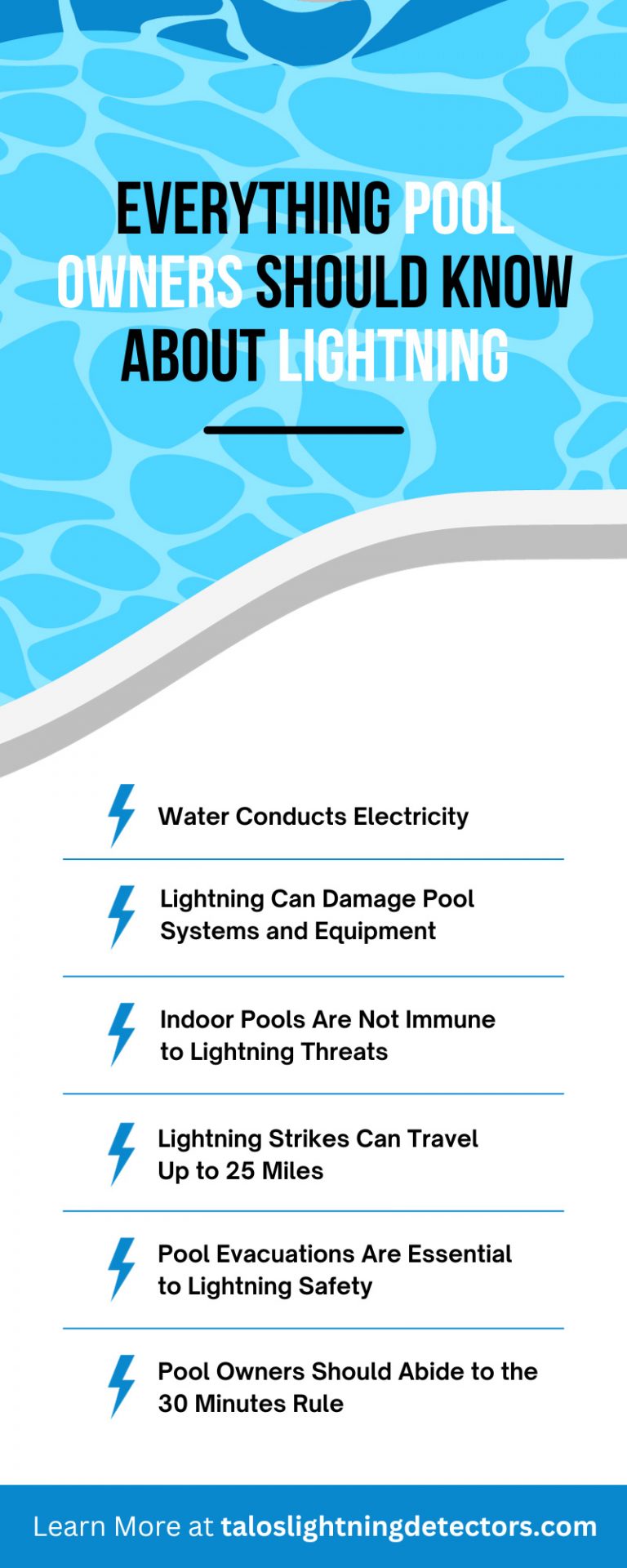Everything Pool Owners Should Know About Lightning

Pools make a great home addition and community amenity. However, they also pose a lot of danger risks, from drowning incidents to physical injuries. The most fatal pool hazard is electrocution, in which lightning can play a major role.
Whether you own and manage a private or public pool, lightning safety is crucial to keeping your pool grounds a safe space. Find out everything pool owners should know about lightning to better prepare and enhance the safety of your pool.
Water Conducts Electricity
Electricity conductors are objects and materials that allow the flow of electrical charges to travel. Water is an effective conductor of electricity, spreading dangerous electrical charges throughout its entire reach. Maintaining the flow of electricity is dangerous because it expands where the charges can go. The greater the electricity’s reach, the higher the risks of electrocution.
Unlike metal rods or wires that contain the electrical flow and generate a single movement path, water allows electrical charges to spread fast and flow in all directions, giving you less control over the situation.
As large bodies of water, pools are powerful electrical conductors. When lightning strikes your pool, the water and surrounding area become a high-risk danger zone for electrocution.
Lightning Can Damage Pool Systems and Equipment
Lightning bolts can consist of about 300 million volts and 30 thousand amps. Most electrical appliances and systems you use can handle up to 240 volts and 60 amps. A surge of charges beyond those voltage and amplification limits can overpower and destroy your electrical systems.
Lightning can damage many electrical aspects of your pool system, including the
- Pumps
- Filter
- Heater
- Lights
- Jets
Using ground fault circuit interrupters can protect your pool’s electrical systems and nearby outlets from a lightning strike power surge. Ground interrupters trigger an emergency power shut-down, stopping electricity flow to your systems’ electrical components. Staying situationally aware of lightning threats and manually shutting off your pool’s power supply also prevents lightning damage.
Indoor Pools Are Not Immune to Lightning Threats
Indoor pools may not have the same exposure risks to lightning threats as outdoor pools, so you may not think that swimming during a storm is a problem. However, lightning strikes can still affect indoor pools and swimmers. The National Weather Service, National Lightning Safety Institute, and the National Athletic Trainers Association all recommend pool evacuations for indoor pools in the case of potential lightning threats.
Swimmers should evacuate the pool and pool area and dry up to enhance their safety and reduce potential electrocution dangers. Whether lightning strikes the building or nearby, its powerful electrical charges can travel far, especially when water is involved. Charged and spreading electrical currents can get into your electrical systems, into your building, and into your indoor pool. Being wet, surrounded by water, or near conductive metals can make you a hot target to the electrical currents and put you at risk of electrocution.
Lightning can also power surge your pool building’s electrical and plumbing systems, causing your pool’s lighting, filtering, and heating systems to shut down and malfunction. Any damage to the indoor pool’s electrical systems can enhance electrocution risks, putting swimmers in further danger. Grounding your building and indoor electrical circuits ensures your pool’s electrical and plumbing remain functional and undamaged. Staying aware of lightning threats and pool evacuations also makes sure people using your indoor pool stay safe from potential electrocution dangers.
Lightning Strikes Can Travel Up to 25 Miles
Light travels through space quickly. As a powerful bolt of light, lightning travels both fast and far. It can strike up to 25 miles away—stretching 12 miles ahead or behind the center of a storm—with a speed of about 186 thousand miles per second. Lightning strikes fast, giving you little to no time to get away and dodge a moving bolt. At the first sign and warning of lightning, you need to clear out the pool.
An age-old rule of thumb is that when thunder roars, you head indoors. Sound moves slower than light, meaning thunder always follows after a lightning strike. When you hear thunder, lightning activity is happening nearby. On top of alerting you of lightning presence, thunder is also an indicator of lightning distance.
You can hear thunder from 10 miles away. Since lightning can strike 25 miles away, hearing thunder means you are well within striking range.
Pool Evacuations Are Essential to Lightning Safety
Swimming in a thunderstorm is dangerous because you increase your chances of getting electrocuted. At the first sign of a storm or lightning, you should evacuate the pool.
Lightning will strike anything in its path, making tall and out-in-the-open objects likely targets. Clearing the pool’s grounds and going indoors puts distance between you and the dangerous bolt and shelters you in coverage. Pool evacuations are essential to lightning protection and pool safety.
Since lightning travels fast, the sooner you clear out the pool, the better. TALOS’ pool lightning detector detects and alerts you of approaching storms and lightning threats within distances of 25, 16, and six miles. With a pool lightning detector, you can improve your situational awareness and have you and other pool users quickly seek shelter before lightning risks escalate.
Pool Owners Should Abide to the 30 Minutes Rule
After a storm subsides, lightning threats are still a possibility, especially if the storm is less than 25 miles away from your pool area. Weather and safety experts recommend that people should wait at least 30 minutes after the last thunder roar before heading back to the pool. Waiting 30 minutes after your last TALOS lightning detector alert is also a good way to gauge the safety of swimming again.
Familiarizing yourself with everything pool owners should know about lightning and using our pool lightning detectors enhances your pool’s safety and functionality. Lightning is beautiful but dangerous, and it’s especially threatening when bodies of water come into play. Stay aware of lightning and the risks it poses to your pool with these lightning facts and TALOS lightning detectors.

Request a Quote
"*" indicates required fields
At TALOS, Engineering Drives Best-in-Class Quality
Our mission is to provide families with quality products that promote safety and awareness while enjoying leisure activities together. Our patent pending products feature the same technology used in expensive weather stations, but at a fraction of the price.
SHOP NOW
Don’t just take our
word for it.
At TALOS®️, we're developing that technology into new innovative concepts designed for enhancing consumer lifestyles.